

Topstitched Darts,Three Ways A Guide to Shirring Preparing Fabric You can add shirring before or after garment construction.
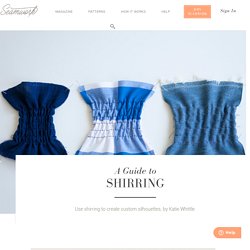
Shirring on a blouse will usually be sewn mid-way through construction, after sewing the side seams, which ensures that the shirring aligns throughout the waist and at the side seam. In this example, the side seams on the Akita dress are pre-finished with bias binding. Shirring was added to the dress front and back before constructing the garment, to create a professional finish. Shirring is created by sewing multiple parallel rows of stitching. The Biggest Problem When Hemming Your Pleats - Tom's Sons International Pleating. Make A Pleating Board. Serger Darts for Knits. Pamela Leggett Photo: Pamela Leggett Darts are notoriously difficult to sew in knits, especially if working with a very stretchy, thin knit.

Serging a dart is a bit unorthodox, but you will be astounded by how easy it is to do and how good the results are. In this tutorial, serger expert and instructor Pamela Leggett shares her method for achieving great-looking darts in knits by using a serger. This technique and others will be covered in greater depth in Pamela's upcoming serger online video brought to you exclusively by Threads and Craftsy. Ribboned Pleats at Dior Haute Couture. Christian Dior, Haute Couture, SS15, Paris.
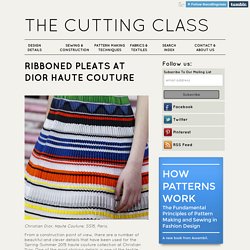
From a construction point of view, there are a number of beautiful and clever details that have been used for the Spring-Summer 2015 haute couture collection at Christian Dior. One of the most striking details is one of the textile embellishments where rows of ribbon have been sewn to a base fabric to form pleated skirts and to create bouncy silhouettes. The process of creating these amazing textiles has been captured as part of a video following the construction of a single dress from the collection.
The video by Visionaire and Refinery29 is embedded below or can be viewed at Refinery29» While videos like this are very insightful for those who have studied fashion or work in the fashion industry, there are a number of details that may need some additional explanation to help you truly appreciate how much work and planning has gone into these garments. Testing the Design and Construction Methods. An Easy Way to Accurately Pleat Ribbon for Trims. I was teaching a class recently for the Massachusetts chapter of the Window Coverings Association of America.

We were making samples of different trims, and I demonstrated how to mark muslin with a permanent marker. A question arose during the class: How can one quickly and easily mark the pleats on finished fabric? House of Marmalade: Darting About. Today I have mostly been sewing darts using a method i've seen in various places on the interweb.

It works a treat! First of all mark the bottom of your dart with a little cut on each leg. Then fold the dart, aligning the two cuts. On your sewing machine, make sure your top thread (the one that goes through the needle) is quite long. Place the piece under your presserfoot and sew one or two stitches. SewNso's Sewing Journal: pleating 101. Pleating 101 There are a few ways to pleat fabric for smocking, but the easiest and fastest way is by using a smocking pleater.
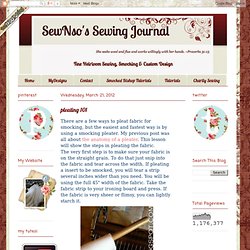
My previous post was all about the anatomy of a pleater. This lesson will show the steps in pleating the fabric. Four square walls: how to gather fabric with a serger. Darlings!
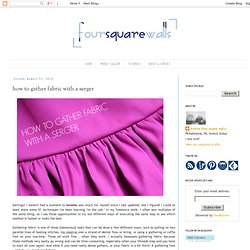
I haven't had a moment to breathe sew much for myself since I last updated, but I figured I could at least share some lil' techniques I've been learning "on the job. " In my freelance work, I often sew multiples of the same thing, so I use those opportunities to try out different ways of executing the same step to see which method is fastest or looks the best. Gathering fabric is one of those [obnoxious] tasks that can be done a few different ways, such as pulling on two parallel lines of basting stitches, zig-zagging over a strand of dental floss or string, or using a gathering or ruffle foot on your machine. Those all work fine... when they work. I actually haaaaate gathering fabric because those methods very easily go wrong and can be time-consuming, especially when your threads snap and you have to start all over again.
I knew in the back of my mind that sergers could gather fabric, but I had never tried it. The first step is to set up your serger for four-thread overlock. How to Create a Notched Tuck. You can use this irresistible tuck treatment on anything you sew.
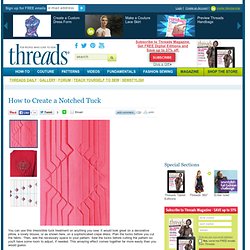
It would look great on a decorative pillow, a lovely blouse, or as shown here, on a sophisticated crepe dress. Plan the tucks before you cut the fabric. Then, add the necessary space to your pattern. Sew the tucks before cutting the pattern so you'll have some room to adjust, if needed. This amazing effect comes together far more easily than you would guess.Line up and baste folds into shapeStart by planning a template for the tucks. Frabjous Couture: Couture Technique: One-thread Dart.
Why use it: One thread-dart - stitched starting from a dart point – eliminates unsightly thread tails at the point.

In addition, Roberta Carr in her great book “Couture… The Art of Fine Sewing” argues that this type of dart has a smoother, pucker-free point and is easy to press. Creating Cartridge Pleats - The Cutting Class. Alexander McQueen, AW13, Paris.
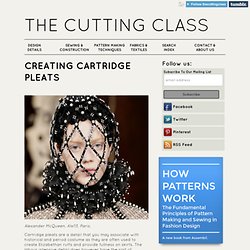
Cartridge pleats are a detail that you may associate with historical and period costume as they are often used to create Elizabethan ruffs and provide fullness on skirts. The labour intensive detail does however have the sort of beautiful structure that is often used in contemporary garments, and can easily be appropriated into collections today as both a structural or decorative detail. Cartridge pleats are formed when the fabric folds back and forth in a similar formation to an accordion pleat, except that cartridge pleats are typically more rounded, creating a signature “figure 8” style structure. Basic Cartridge Pleat Construction The first step is to mark the pleat intervals that you need onto fabric to ensure that your finished pleats will be perfectly consistent in size and shape. Video: Creating ruffles on a serger with Bernina
Today’s tutorial is brought to you by Bernina, who created this quick video that demonstrates one of my favorite (and often overlooked) features of the home serger: the ability to create fast and easy ruffles. There are several benefits to creating ruffles on a serger instead of gathering by pulling basting stitches: It’s really fast. As you can see in the video, you just set the machine up and feed the fabric through. It’s far less time consuming.The gathers are even. There’s no hand adjustments needed, so it’s far less tedious to create perfect ruffles.You can gather and sew in one step.
[make better ruffles] Ruffles rock. (just like you.) This is a long post about lots of ways to gather ruffles for different effects.